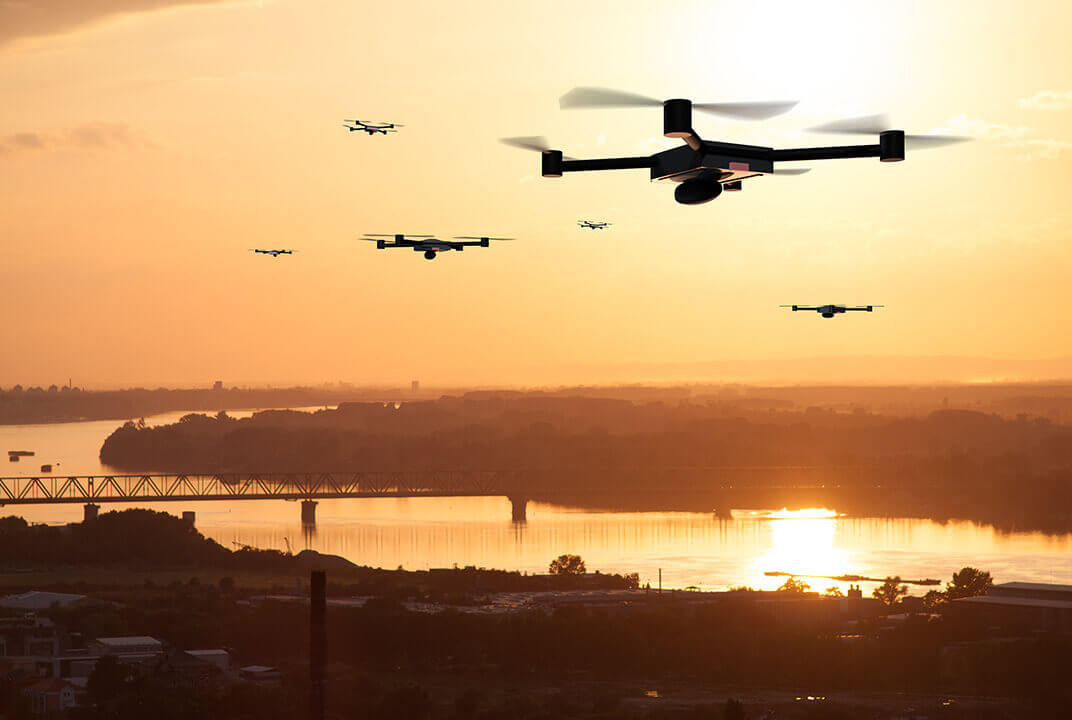UAV airspace access a step closer thanks to Inmarsat’s latest tech signing
Aviation
Innovation firm TTP to develop compact, lightweight and low-cost satcom terminal to integrate uncrewed aerial vehicles into commercial airspace, as part of Iris programme
Inmarsat and the European Space Agency (ESA) today announced the development of a compact satellite terminal for Uncrewed Aerial Vehicles (UAVs) as part of the ground-breaking Iris air traffic modernisation programme: paving the way for UAVs to be safely integrated into commercial airspace.
TTP will deliver the core technology for a low size, weight, power and cost (SWaP-C) terminal with an integrated antenna. The advanced terminal, available later this year, will be suitable for almost all UAVs, providing a secure and always-available datalink between uncrewed vehicles, remote operators and air traffic control.
The miniaturised Inmarsat terminal brings scalable Beyond Visual Line of Sight (BVLOS) operations and will unlock a range of possibilities for flight operators such as telemetry for platform health monitoring, IP voice relay for air traffic control communications, and data services such as video streaming for inspection applications. Optional hybrid connectivity will also be integrated within the terminal and can be utilised where cellular coverage is available, ensuring a seamless experience through the intelligent routing of data and services.
As part of Iris, TTP is also contracted for research and development of UAV safety services, for example last mile tactical deconfliction, known as detect and avoid (DAA). This, alongside the new UAV satcom terminal and technology from other Iris partners, will help deliver all elements needed for UAVs to safely operate in commercial airspace.
Anthony Spouncer, Inmarsat’s Senior Director of Advanced Air Mobility (AAM), said “The number of uncrewed vehicles in mixed airspace is expected to increase tenfold over the next 8-10 years. Through the expertise of TTP, Inmarsat’s new UAV terminal will bring a solution that is scalable, less dependent on infrastructure, and digitalised to benefit air traffic modernisation programmes like Iris.”
Tristan Barkley, TTP’s Head of Satellite and Space said “We have a long history of developing core enabling technology platforms for world-leading companies like Inmarsat and are delighted to support Inmarsat and ESA in safely opening up airspace for UAVs.”
Powered by Inmarsat’s award-winning SwiftBroadband-Safety (SB-S) connectivity platform, Iris enables real-time collaboration between pilots, air traffic controllers and airline operation centres by using cost-effective, secure and highly resilient datalink communications. This relieves pressure on congested Very High Frequency (VHF) links and enabling the use of time-based air traffic management which provides significant benefits like reduced flight delays and costs for airlines. This also lowers unnecessary CO2 emissions to support the aviation industry’s journey towards decarbonisation and less congested skies.
Iris supports the Single European Sky ATM Research (SESAR) programme and will begin flying onboard commercial flights with easyJet in early 2023, making it the first communication service benefiting from a Pan-European certification from the European Union Aviation Safety Agency (EASA), secured through the programme’s partner European Satellite Services Provider (ESSP). This will be followed by Iris Global, which extends the programme’s benefits far beyond Europe, leading to larger CO2 reductions and improved airspace capacity across the world.
Further information
Notes for editors
TTP’s core terminal technology will be available later this year as a reference design, with an integrated antenna for the smallest form factor, or as a standalone terminal for use with third party antennas. The design will be licensed for manufacture and distribution by Inmarsat’s ecosystem of suppliers, enabling Value-Added Manufacturers (VAMs) to accelerate the development of new products, as well as removing barriers around miniaturised technology for rapid market access.
About Inmarsat
Inmarsat delivers world leading, innovative, advanced and exceptionally reliable global, mobile communications across the world – in the air, at sea and on land - that are enabling a new generation of commercial, government and mission-critical services. Inmarsat is powering the digitalisation of the maritime industry, making operations more efficient and safer than ever before. It is driving a new era of inflight passenger services for aviation, while ensuring that aircraft can fly with maximum efficiency and safety. Furthermore, Inmarsat is enabling the rapid expansion of the Internet of Things (IoT) and enabling the next wave of world-changing technologies that will underpin the connected society and help build a sustainable future. And now Inmarsat is developing the first-of-its-kind, multi-dimensional communications network of the future, ORCHESTRA.
In November 2021, Inmarsat and Viasat announced the planned combination of the two companies, to create a new leader in global communications.
For further information, follow us: Twitter | LinkedIn | Facebook | YouTube | Instagram.
Contact for media
About TTP
TTP is a technology and product development services company based in the Cambridge (UK) technology cluster. For 35 years the company has been delivering science & technology driven innovation to clients in a wide range of sectors, including aerospace, where we are working with global leaders who benefit from TTP’s exposure to other industry sectors and technologies. TTP’s focus areas include:
- User terminals and antennas for satellite connectivity, including for UAVs
- UAV Detect and avoid (DAA) technology
- 5G Non-Terrestrial Networks (NTN)
- Intersatellite links
- Space sustainability solutions.
TTP has extensive experience in the development of terrestrial and satellite communication solutions – from system level down to devices, from VHF to V-band, from land-based equipment to aeronautical and space-based platforms.

